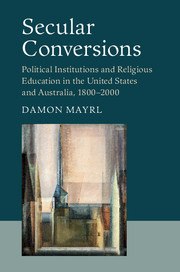 Secular Conversions
Secular Conversions Book contents
- Frontmatter
- Contents
- List of Figures and Tables
- Acknowledgments
- List of Acronyms
- Introduction
- 1 Politics, Institutions, and Secularization
- Part I Forging the nineteenth-century settlement
- Part II The nineteenth-century settlement in transition
- 3 Slow Secularization in the Permeable American State
- 4 Settlement Stability in the Insulated Australian State
- Part III Forging the twentieth-century settlement
- Part IV Implications
- Epilogue: Toward a Twenty-First-Century Settlement?
- Index
4 - Settlement Stability in the Insulated Australian State
from Part II - The nineteenth-century settlement in transition
Published online by Cambridge University Press: 05 August 2016
- Frontmatter
- Contents
- List of Figures and Tables
- Acknowledgments
- List of Acronyms
- Introduction
- 1 Politics, Institutions, and Secularization
- Part I Forging the nineteenth-century settlement
- Part II The nineteenth-century settlement in transition
- 3 Slow Secularization in the Permeable American State
- 4 Settlement Stability in the Insulated Australian State
- Part III Forging the twentieth-century settlement
- Part IV Implications
- Epilogue: Toward a Twenty-First-Century Settlement?
- Index
Summary
INTRODUCTION
In 1938, the eminent comparative educationist Isaac Kandel surveyed the structure and operation of Australian education. He was struck by its “high degree of centralization,” which had commendably “brought facilities for education within the reach of all children of school age.” Nevertheless, Kandel sounded an alarm. “The efficiency attained by centralized control may be purchased at too great a price. A central authority tends to grow by the power which it wields and when such an authority exercises at once the rights to legislate, … to execute, and to judge, the result is inevitably rule by a bureaucracy which imposes its will and ultimately secures uniformity in aspects of the educational process where uniformity is least desirable.”
Kandel was not the first observer – nor would he be the last – to remark upon the highly centralized administration of Australian education, nor to raise concerns about its sclerotic effects on educational practice. Just a year before Kandel published his study, an education conference held in Sydney featured a virtual parade of speakers urging Australians to break the shackles of bureaucratic rule. The Sydney Mail reported, “Behind all the discussions and lectures at the conference was an evident urge to condemn educational methods that are based on rigid centralization.” Australian education at midcentury was, in fact, highly centralized. Under the Australian system, the state education departments coordinated and controlled all aspects of schooling, from staffing and curriculum to teacher training. Despite moves in the last decades of the twentieth century to decentralize administration, to this day Australian education remains remarkably centralized, with power concentrated in state departments and very few real powers delegated to the local level.
This chapter examines how Australia's centralized education system affected the pace and timing of secularization in Australian schools. In contrast to the United States, where devotional Bible reading declined over the first half of the twentieth century, religious instruction persisted, and even became more widespread, in Australian schools. In many states, students in 1960 encountered religion in the curriculum in much the same way that their great-grandparents might have encountered it in 1880; in others, they encountered a more robust religious presence.
- Type
- Chapter
- Information
- Secular ConversionsPolitical Institutions and Religious Education in the United States and Australia, 1800–2000, pp. 120 - 156Publisher: Cambridge University PressPrint publication year: 2016
